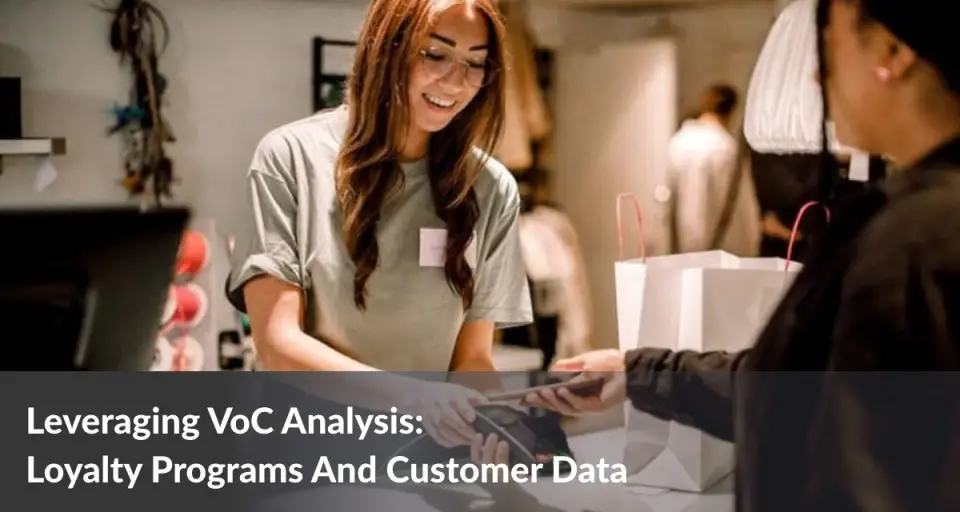The voice of the customer (VoC) has long been a crucial determinant of business success. As companies focus more on customer experience, understanding the customer’s voice becomes paramount. This is where VoC analysis can come into play.
In a previous article, I outlined how data analytics is transforming loyalty programs. Along these lines, I see VoC analysis as a strategic lens that can help you discern customers’ ever-evolving needs, preferences and pain points. It’s not just about listening; it’s about translating insights into actionable strategies that foster growth and lasting relationships.
The Importance Of VoC Analytics
Recent studies reveal the undeniable impact of VoC analytics.
- Increased customer retention. A study found that brands employing advanced VoC strategies experienced a 55% higher customer retention rate.
- Enhanced brand loyalty. 70% of customers reported higher brand loyalty when their feedback, once asked for, was acted upon.
- Improved customer satisfaction. Businesses utilizing VoC analytics recorded a 14.5% uptick in overall customer satisfaction scores within a year.
These findings confirm that VoC isn’t just a trendy business strategy; it’s essential for staying competitive and retaining customers.
Pairing VoC Analysis With Loyalty Programs
As someone who leads a company that provides a platform for loyalty programs, I’ve seen how VoC analysis can share a symbiotic relationship with loyalty programs. These loyalty programs are a rich means to engage directly with customers and collect valuable data about purchasing behaviors and preferences.
The data you get from VoC analysis can then offer deep insights into customer sentiments, expectations and pain points. Reinforcing your loyalty program, you can use these insights to help refine and optimize your offerings, ensuring their relevance and appeal.
With around 77% of consumers participating in a retail loyalty program, I believe combining these programs with VoC analysis presents a golden opportunity.

Tapping Into VoC Data Through Loyalty Programs
Here are some techniques to get the necessary data and insights for your VoC analysis.
1. Rich Data Collection
By integrating something like a receipt scanning feature into your loyalty program, you can tailor marketing and product recommendations, incentivize spending in their ecosystem and introduce targeted bonus points tied to specific products or behaviors. You can look to this data to help introduce new products, bundle popular items together or liquidate older inventory.
2. Zero-Party Data
Encouraging customers to share their preferences openly through surveys and quizzes can allow your brand to tailor experiences precisely without relying on assumptions. Consider a café looking to improve its offerings. By leveraging a loyalty program, the café can poll customers on new beverage flavors. This adds a personal touch and ensures that customer preferences drive business decisions.
3. First-Party Data
Engaging directly with customers, whether through their loyalty program profile, purchase history, online interactions or feedback, can help provide invaluable insights for businesses in anticipating customer needs. For instance, a bookstore that observes a surge in sales for historical fiction could proactively enhance its inventory with related titles or organize events tailored to this genre.
4. Personalized Offerings
Use VoC analysis to not just see what customers are saying but also what they feel. For example, upon realizing that customers value cashback rewards, your brand might prioritize offering this as a part of your loyalty rewards.
5. Feedback Loop
Check-in with the data regularly. I find that maintaining an ongoing data collection and analysis cycle is vital to staying attuned to the evolving landscape of customer preferences. For example, a cosmetics brand might find through VoC that customers are shifting towards vegan products and then adapt their loyalty rewards accordingly.
6. Predictive Analysis
Model the data to make predictions and help foresee surges in demand. For example, data from your VoC analysis might highlight that beverages will become more popular as summer approaches, and you can use this information to strategically plan and design incentives.
Boosting Customer Retention Through Enhanced Loyalty Programs
Stronger loyalty programs from better VoC analytics can ultimately result in improved customer retention. According to Bain & Company, a 5% increase in customer retention can lead to a 25% to 95% increase in profits. Use these three pillars to make sure you are using your insights to properly drive retention.
1. Relevance
Using your VoC analysis, make sure that your rewards resonate on a profound level. For instance, most streaming services use customer viewing history and feedback to serve up genre-specific recommendations.
2. Engagement
Consider a loyalty app from a fitness brand that is tailored to reward users for achieving fitness milestones based on self-reported progress. This type of approach can result in a notable uptick in app usage, showcasing the power of customer-centric design.
3. Trust
There’s a profound understanding that customer feedback isn’t just data; it’s a catalyst for building trust. Consider a scenario where a restaurant, leveraging VoC analysis, crafts and modifies its menu based on the insights shared by its patrons. The result? An enhanced dining experience that resonates with their customers, potentially translating into a surge of repeat visits and solidifying brand loyalty.
Conclusion
In the dynamic landscape of modern business, VoC analysis combined with customer loyalty programs is a potent tool for success. As companies tap into the rich reservoir of customer data through integrated loyalty programs, they are better equipped to hear, understand and act upon the voice of their most valuable asset: the customer.
The rewards, as statistics suggest, are not just in customer satisfaction but also in business growth. And in this symbiotic relationship, I believe that businesses that remain committed to listening will lead in the race for customer loyalty.
This article was originally published on Forbes.com by Zinrelo’s co-founder and Forbes Business Council Member, Jai Rawat.
Ready to Build Your Loyalty Program With Zinrelo?
Leverage the VoC data to transform your business.


